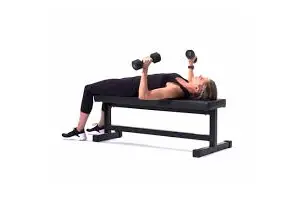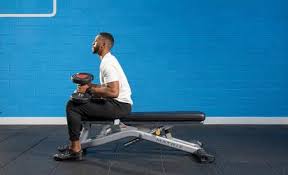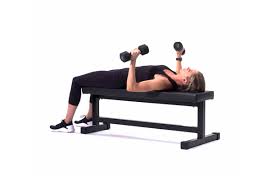Mastering the Dumbbell Bench Press: A Comprehensive Guide to Building Upper Body Strength
The dumbbell bench press is a fundamental strength-training exercise that targets the chest, shoulders, and triceps. It involves lifting dumbbells while lying on a bench, promoting balanced muscle development and upper body strength. Perfecting form and starting with appropriate weights are key for beginners. Gradual progression ensures safe and effective results over time.
Perfecting Your Dumbbell Bench Press Form for Maximum Gains

In the realm of strength training, few exercises hold as much significance as the dumbbell bench press. This fundamental compound movement has earned its place as a cornerstone of upper body workouts, revered for its ability to target the chest, shoulders, and triceps with precision. The simplicity of its execution belies its profound impact on muscle development and overall strength.
The Fundamentals of the Dumbbell Bench Press
The dumbbell bench press, a quintessential strength-training exercise, lays the foundation for upper body development. Its execution demands a precise amalgamation of form, control, and strength.
- Setup and Positioning:
- Commence by lying flat on a bench, ensuring your feet are firmly planted on the ground. Grasp a dumbbell in each hand, holding them at chest level with your arms extended.
- Grip and Hand Placement:
- Hold the dumbbells with a firm grip, ensuring that your palms are facing forward. Your hands should be slightly wider than shoulder-width apart, allowing for a balanced distribution of weight.
- Engaging Your Core:
- Prior to initiating the movement, engage your core muscles. This stabilizes your torso and provides a solid foundation for the exercise.
- Lowering Phase:
- Begin the exercise by gently lowering the dumbbells towards your chest. Maintain control throughout this phase, ensuring that your elbows form a 90-degree angle or slightly descend below it. Your elbows should be positioned just below your shoulders.
- Pressing Phase:
- Exhale as you exert force to push the dumbbells upward, returning them to the starting position. Extend your arms fully without locking out your elbows.
- Breathing Technique:
- Coordinate your breath with the movement. Inhale as you lower the weights, and exhale as you press them back up. This controlled breathing rhythm helps stabilize your core and optimize your performance.
- Maintaining Proper Form:
- Throughout the exercise, it's crucial to maintain a neutral spine and keep your feet flat on the ground. Avoid excessive arching of your lower back or lifting your feet off the ground.
- Controlled Tempo:
- Emphasize a controlled tempo throughout the exercise. Avoid rapid movements or bouncing the weights off your chest, as this can lead to loss of control and potential injury.
- Focus on Muscle Engagement:
- Concentrate on engaging your chest, shoulders, and triceps throughout the movement. Visualize the muscles at work to enhance the mind-muscle connection.
- Avoiding Overextension:
- Refrain from overextending your arms at the top of the movement. This helps prevent unnecessary strain on your shoulder joints.

Benefits of the Dumbbell Bench Press
The dumbbell bench press is a versatile and effective exercise that offers a wide range of benefits for individuals seeking to improve their upper body strength and physique.
- Targeted Muscle Engagement:
- The dumbbell bench press primarily targets the pectoral muscles (chest), making it an excellent exercise for developing chest strength and size. Additionally, it engages the deltoids (shoulders) and triceps, creating a comprehensive upper body workout.
- Balanced Muscle Development:
- Unlike some exercises that may favor one side of the body, the dumbbell bench press requires each arm to work independently. This helps address any strength imbalances between your left and right sides, promoting balanced muscle development.
- Improved Stability and Core Strength:
- Using dumbbells instead of a barbell requires greater stability, as each arm must independently support its share of the weight. This engages stabilizing muscles in the shoulders, chest, and core, enhancing overall stability and strength.
- Reduced Risk of Injury:
- The independent movement of each arm in the dumbbell bench press can help prevent or correct imbalances that may lead to injuries over time. This can contribute to long-term joint health and injury prevention.
- Increased Range of Motion:
- Dumbbells allow for a greater range of motion compared to a barbell. This enables a deeper stretch and contraction of the chest muscles, leading to improved muscle growth and flexibility.
- Versatility with Incline and Decline Variations:
- By adjusting the angle of the bench (incline or decline), you can shift the emphasis of the exercise to target different areas of the chest. This versatility allows for a more customized workout tailored to your specific goals.
- Enhanced Mind-Muscle Connection:
- Because you are working with each arm independently, you can focus more on the mind-muscle connection, ensuring that you are actively engaging the target muscles throughout the entire range of motion.
- Effective for Home Workouts:
- The dumbbell bench press can be performed at home if you have access to a bench and a set of dumbbells. This makes it a convenient exercise option for those who prefer to workout at home or may not have access to a gym.
- Suitable for All Fitness Levels:
- The dumbbell bench press can be adapted for various fitness levels. Beginners can start with lighter weights and gradually progress, while advanced lifters can challenge themselves with heavier dumbbells or incorporate advanced variations.
- Improved Aesthetic Appearance:
- Building a strong and well-defined chest through exercises like the dumbbell bench press can enhance your overall aesthetic appearance, giving you a more balanced and sculpted upper body.
Variations of the Dumbbell Bench Press
The dumbbell bench press offers a versatile platform for targeting various areas of the chest and enhancing overall upper body strength.
- Incline Dumbbell Bench Press:
- Focus: Upper Chest
- Description: Perform the bench press on an incline bench (usually set at 30-45 degrees). This variation places greater emphasis on the upper chest and shoulders, helping to develop a well-rounded chest.
- Decline Dumbbell Bench Press:
- Focus: Lower Chest
- Description: Utilize a decline bench (angled downward) to shift the focus towards the lower chest. This variation targets the lower pectoral muscles, creating a well-defined and balanced chest appearance.
- Single-Arm Dumbbell Bench Press:
- Focus: Unilateral Strength and Stability
- Description: This variation requires performing the bench press one arm at a time. By isolating each side, you can identify and address any strength imbalances, while also engaging stabilizing muscles more intensely.
- Neutral-Grip Dumbbell Bench Press:
- Focus: Triceps Emphasis
- Description: Instead of a traditional grip, hold the dumbbells with a neutral grip (palms facing each other). This variation places greater emphasis on the triceps, making it an effective exercise for targeting the back of the arms.
- Close-Grip Dumbbell Bench Press:
- Focus: Triceps Emphasis
- Description: Position your hands closer together on the dumbbells, effectively narrowing your grip. This places increased emphasis on the triceps and can be particularly effective for individuals looking to strengthen this muscle group.
- Alternating Dumbbell Bench Press:
- Focus: Unilateral Strength and Stability
- Description: Alternate pressing one dumbbell at a time while keeping the other arm extended. This variation engages stabilizing muscles and requires focused control throughout the movement.
- Isometric Dumbbell Bench Press:
- Focus: Time Under Tension
- Description: Hold the dumbbells at the midpoint of the bench press (slightly above your chest) and maintain this position for a specific duration. This variation increases time under tension, which can lead to enhanced muscle growth and strength gains.
- Negative (Eccentric) Dumbbell Bench Press:
- Focus: Strength Building
- Description: Focus on the lowering (eccentric) phase of the bench press. Use heavier dumbbells than you would for a standard press, and have a spotter assist with the lifting phase if needed. This variation helps build strength through controlled negatives.
- Plyometric Dumbbell Bench Press:
- Focus: Power and Explosiveness
- Description: This advanced variation involves explosively pushing the dumbbells off your chest, allowing them to briefly leave your hands before catching them on the way down. This plyometric movement helps develop power in the chest and shoulders.

Incorporating the Dumbbell Bench Press into Your Routine
The dumbbell bench press is a foundational exercise that can significantly enhance your upper body strength and muscle development.
- Warm-Up Adequately:
- Before beginning any strength training session, it's crucial to warm up your body to increase blood flow, improve flexibility, and prepare your muscles for the workout ahead. Engage in 5-10 minutes of light cardiovascular activity, such as brisk walking, jogging, or cycling.
- Select Appropriate Dumbbells:
- Choose a pair of dumbbells that are suitable for your current strength level and allow you to maintain proper form throughout the exercise. It's important to start with a weight that challenges you but still allows for controlled and safe movement.
- Positioning and Set-Up:
- Lie flat on a bench with your feet planted firmly on the ground. Hold a dumbbell in each hand, positioning them at chest level with your arms extended. Ensure your back, head, and buttocks remain in contact with the bench throughout the exercise.
- Execute the Dumbbell Bench Press:
- Follow the proper form outlined earlier, including the controlled lowering and pressing phases. Remember to engage your core and maintain a steady breathing rhythm.
- Determine Sets and Reps:
- The number of sets and repetitions you perform will depend on your fitness goals. For general strength and muscle building, aim for 3-4 sets of 8-12 repetitions. Adjust the weight accordingly to challenge yourself while maintaining proper form.
- Rest Between Sets:
- Allow yourself adequate rest between sets to allow for muscle recovery. Rest periods of 1-2 minutes are typically suitable for strength training exercises like the dumbbell bench press.
- Incorporate Progressive Overload:
- To continue making progress, gradually increase the weight you use for the dumbbell bench press. This concept, known as progressive overload, challenges your muscles to adapt and grow stronger over time.
- Combine with Other Exercises:
- To create a well-rounded upper body workout, incorporate the dumbbell bench press with complementary exercises. This may include movements targeting different muscle groups, such as shoulder presses, triceps dips, or chest flyers.
- Maintain Consistency:
- Consistency is key to seeing progress in your strength and muscle development. Aim to include the dumbbell bench press in your workout routine on a regular basis, ensuring that it becomes a staple exercise in your regimen.
- Listen to Your Body:
- Pay attention to how your body responds to the exercise. If you experience any discomfort or pain (beyond normal muscle fatigue), stop the exercise and seek advice from a fitness professional or healthcare provider.
What muscles do dumbbell bench press work
The dumbbell bench press is a compound exercise that primarily targets the muscles of the chest, shoulders, and triceps.
- Pectoralis Major (Chest Muscles):
- The pectoralis major is the primary muscle engaged in the dumbbell bench press. It consists of two parts: the clavicular head (upper chest) and the sternal head (lower chest). This exercise helps to develop both portions of the chest.
- Deltoids (Shoulder Muscles):
- The anterior (front) portion of the deltoid muscles is heavily involved in the dumbbell bench press. They assist in the initial phase of the press, aiding in lifting the dumbbells off the chest.
- Triceps Brachii (Triceps Muscles):
- The triceps brachii, located at the back of the upper arm, play a significant role in the extension phase of the bench press. They assist in straightening the arms and pushing the dumbbells upward.
- Serratus Anterior:
- The serratus anterior, located along the sides of the ribcage, helps stabilize the shoulder blades during the bench press. This muscle group is crucial for maintaining proper form and shoulder stability.
- Coracobrachialis (Assisting Muscle):
- While not a primary mover, the coracobrachialis, located deep in the front of the arm, aids in the flexion of the shoulder joint.
- Biceps Brachii (Assisting Muscle):
- The biceps brachii, located at the front of the upper arm, are engaged to a lesser extent as they assist in stabilizing the shoulder joint during the press.
- Latissimus Dorsi (Assisting Muscle):
- The latissimus dorsi, located on the back, help stabilize the shoulder blades and provide stability during the movement.
- Trapezius (Upper Portion, Assisting Muscle):
- The upper portion of the trapezius, located on the upper back and neck, aids in shoulder movement and stability.
- Rhomboids (Assisting Muscle):
- The rhomboids, situated between the shoulder blades, play a role in stabilizing the shoulder blades during the bench press
How much weight should a beginner dumbbell bench press
For beginners, it's crucial to start with an appropriate weight that allows you to perform the dumbbell bench press with proper form and control. This will help prevent injury and allow for steady progress over time.
- Select a Light Weight to Begin:
- As a beginner, it's advisable to start with lighter dumbbells to familiarize yourself with the movement and ensure proper form. A weight that allows you to perform 3 sets of 10-12 repetitions with good form is a good starting point.
- Focus on Form and Technique:
- Prioritize proper form over heavy weights. It's essential to master the correct technique before gradually increasing the weight. This ensures that you target the intended muscle groups and reduce the risk of injury.
- Perform a Warm-Up Set:
- Begin with a very light set of dumbbells (or even just the weight of your arms) to warm up your muscles and joints. This helps prepare your body for the exercise and prevents strain.
- Progress Gradually:
- As you become more comfortable with the exercise, gradually increase the weight. Aim to increase by small increments, such as 2.5 to 5 pounds (1-2.5 kg) per dumbbell, as you progress.
- Listen to Your Body:
- Pay attention to how your body feels during the exercise. If you find that the weight is too heavy and compromises your form, reduce the weight to a more manageable level.
- Maintain Control Throughout the Movement:
- You should be able to lift and lower the dumbbells in a controlled manner without using excessive momentum. If you find yourself struggling to control the weight, it may be too heavy.
- Seek Guidance if Uncertain:
- If you're unsure about the appropriate weight to use, consider seeking guidance from a fitness professional or personal trainer. They can provide personalized recommendations based on your current fitness level and goals.
The dumbbell bench press is a foundational exercise that offers a myriad of benefits for upper body strength and muscle development. By mastering proper form and incorporating variations, you can maximize the effectiveness of this compound movement in your fitness routine. Whether you're a novice or a seasoned lifter, the dumbbell bench press is an invaluable tool in achieving your strength and fitness goals.



